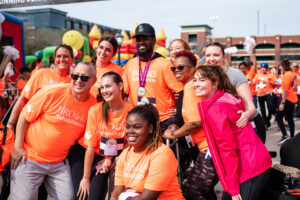Overcoming Adversity: Police Officer Malik Daricaud Returns to Work

Back to physical health resource hub
Officer Malik Daricaud dreamed of being in law enforcement from an early age. His time in the Navy brought him to Jacksonville where he joined the Florida Air National Guard and the police academy at Florida State College at Jacksonville. The two-year patrol officer with the Jacksonville Sheriff’s Office (JSO) tried not to dwell on the dangers of the job… until his own life was on the line.
On March 26, 2023, Daricaud was following up at a home after a traffic stop investigation. He shined his flashlight into the house as the door opened and made eye contact with the person of interest. He then saw a bright burst of light and hit the floor.
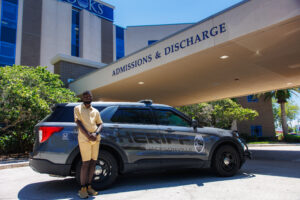
According to JSO, three gunshots were fired from an SKS rifle. One of the bullets hit the flashlight Malik was holding in his hand, sending fragments into his neck and shoulders, causing severe damage.
Police Sgt. Senad Ahmetovic, Police Officer Justin A. Cotton and Police Officer Kerry F. Redmond rushed to pull Daricaud to safety. They were awarded Medals of Valor for their heroic actions that saved his life.
Jasmine Faison, Malik’s wife, remembers hearing the sirens that morning, not realizing her husband was the one in need. Jasmine and his 5-year-old son, Malachi, were Malik’s only thought as he lay there unable to move.
Journey at Brooks
Daricaud was rushed to UF Health Jacksonville. “I remember every bump on that ride because of the pain I was in, until I blacked out,” said Daricaud. It took a day or two before he was lucid and conscious. He spent a week there undergoing a series of evaluations. Once he was stable enough, he was transferred to Brooks Rehabilitation for intensive therapies.
“I didn’t know how bad my injury was and I didn’t know what recovery would look like. I didn’t know if I would ever be able to walk again. In my head, I was already thinking what life might be like and what I might and might not be able to do ever again,” said Daricaud.
Howard Weiss, DO, and a therapy team of Sydney Dalton, PT, DPT, Alexa Shaw, MSOT, OTR/L, and Kameron Stricklin, OTD, OTR/L, were with Malik from day one at Brooks.
“I remember coming to do his first physical therapy evaluation and he wasn’t able to move much at all,” said Dalton. “The bullet went in around the C3-C4 area of his spinal cord, near the base of his neck, so it affects anything below that region. He had more complications on the right side because that’s where the bullet went in, along with damage to the brachial plexus, a network of nerves in the shoulder responsible for movement and signals from the spinal cord to the arms and hands.”
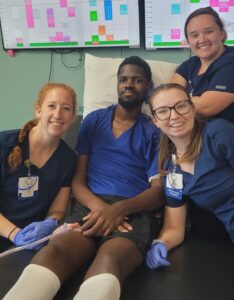
“Malik was severely impaired and in excruciating pain when he first arrived. He was having trouble breathing and dealing with other medical complexities early on, which delayed his therapies. But from the beginning, I promised him he would walk out of our doors,” said Dr. Weiss.
Getting Malik walking again would be no easy task. “There is a clinical prediction rule utilizing the literature that calculates the likelihood of someone walking again,” said Dalton. “I calculated it when Malik first arrived and it was a low percentage. We do see a lot of recovery in patients with incomplete spinal cord injuries, but seeing how impaired he was, I wasn’t sure.”
“Malik was also requiring 100% assistance from 1-2 people with self-care including basic things like brushing his teeth and getting dressed when he came to Brooks due to his medical complexity, pain, etc.,” said one of Malik’s occupational therapists, Kameron Stricklin, OTD, OTR/L.
“I remember how hopeful Malik was despite his current level of function and it made it so easy to root for him,” said Alexa Shaw, MSOT, OTR/L, Malik’s other occupational therapist. “I knew we were going to push as hard as we could to get him as independent as possible with all of his activities of daily living (ADLs).”
Even after a month, the progress ebbed and flowed. Malik was still only able to tolerate low-level interventions like getting out of bed and into an upright position on a tilt table. His blood pressure would drop or the pain was unbearable, even with his strong will and determination.
A Step Towards the Future
“I was having to adapt to always being in pain. Trying to push through it. Dr. Weiss tried different medications and different dosages so I could do something in therapy. Once we got it under control and I was able to just focus on therapy and not the pain, that was the turning point in my recovery,” said Daricaud.
“I remember the first time he sat up on his own. We were practicing balance on the edge of his bed and he says, ‘Unhand me, Sydney!’ So I let go, and I not only got to see him hold himself upright unsupported, but I was starting to see his personality return as well.”
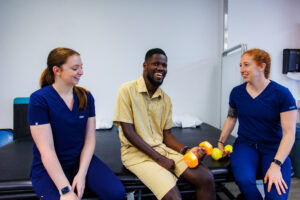
There was a point in Daricaud’s recovery where it took four clinicians to help him stand in parallel bars but that moment showed the team his legs were functioning and he had potential.
“Sitting in a wheelchair for so long, I forgot how tall I was. I remember looking down on my therapists and telling them ‘Wow, you guys are really short!’ It felt really good to get back on my feet again.”
From there, his team used a Moveo (a modified leg press), electrical stimulation and progressed to the Cyberdyne Hybrid Assistive Limb.
“My family and my friend Logan were always there keeping me motivated. And the support that I’ve received from the Agency [JSO] and the community kept me progressing,” said Daricaud.
The American Spinal Injury Association (ASIA) Impairment Scale is used to assess individuals with spinal cord injuries. There are five levels ranging from a complete loss of function to completely normal. When Malik arrived, he was classified as an ASIA C, which means his injury was incomplete that less than half of the muscles below the level of injury are able to move against gravity. Malik is now classified as an ASIA D.
“I felt like I was frozen and things were thawing out. Every day I would get something else back. And every time we would set new goals to keep pushing forward.”
“Individuals with injuries like Malik’s can continue to keep making improvements up to two years after an injury,” said Dr. Weiss. “For him to be able to progress from a C to a D and continue to improve has been awesome,” said Dalton.
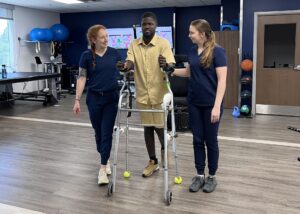
Daricaud is now walking more than 200 feet. He and Dalton continue to work on improving efficiency of walking via high intensity gait training while concurrently working on balance, endurance and overall strength and mobility.
“We’ve gotten to know each other very well,” said Dalton. “One of the most fulfilling parts of my job is being able to connect with my patients on an emotional level while improving their physical function. My priority is Malik’s treatment and care but creating a friendship and getting to know him as a person has been great as well.”
“Malik has worked so hard during his occupational therapy sessions to achieve his independence back. For his instrumental ADL tasks (IADLs), those that help a person care for themselves independently, such as lower body dressing and cooking, Malik can now complete them while standing, which shows how well PT and OT can come together to get a patient back to the things they love to do,” said Shaw.
“He is now able to dress, bathe and drive himself using adaptive controls independently due to his hard work with occupational therapy. He would not be able to perform his job functions or return home without his participation in OT,” said Stricklin.
Returning to Work
Knowing Daricaud’s biggest goal was to return to work with JSO, Dr. Weiss brainstormed possibilities with Sheriff TK Waters and a former law enforcement patient to find the best place for Daricaud’s skills and current level of ability.
He is now working two days per week as an Intelligence Analyst for a unit at JSO called the Real-time Crime Center. “I have a proactive role in assisting officers that are on the streets by getting them information that they wouldn’t have had immediately.” He’s already making a difference.
“We had a ‘shots fired’ event and officers were immediately in the area. The suspect took off running and we were able to view and locate the subject taking off a bag or satchel and dispatched units to locate the bag containing the firearm used. It felt good to know it was off the streets before, God-forbid, a child found it. I function like an ‘eye in the sky’ where I can tune in to different cameras and information and get it out to officers so they can better perform their roles.”
“It has been an honor and a privilege to get to help this veteran and police officer. He was born to be in law enforcement and he will be able to continue doing what he loves. He has a long recovery still ahead, but to get to see him doing more than anyone expected is why I love what I do,” said Dr. Weiss.
“Over the last year of working with Malik I know a friendship has formed that I will cherish for a long time to come,” said Shaw. “I am so grateful for everything I have learned from Malik, like how to be strong through adversity, be loving when we are scared and believe in ourselves no matter what.”
For now, Malik is most excited about adjusting back to being a parent and a husband as he continues his recovery.
